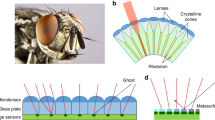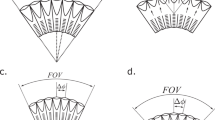Abstract
Many arthropods have compound eyes, made up of numerous separate visual units or ommatidia. In apposition eyes, the ommatidia are optically isolated from each other and provide a poor photon catch because the lenses are so minute1. Much more efficient use of the eye's surface is obtained in superposition eyes, where many ommatidia cooperate to form a superimposed image on the retina1. I report here that, contrary to previous belief2, the eyes of many crabs and hermit-crabs work as superposition eyes by employing imaging optics of a conceptionally new kind. Imaging is accomplished by a remarkable combination of ordinary lenses, cylindrical lenses, parabolic mirrors and light-guides. Despite the impressive complexity of the new mechanism, it is easy to see how this parabolic superposition eye must have evolved from an ordinary apposition compound eye.
This is a preview of subscription content, access via your institution
Access options
Subscribe to this journal
Receive 51 print issues and online access
$199.00 per year
only $3.90 per issue
Buy this article
- Purchase on Springer Link
- Instant access to full article PDF
Prices may be subject to local taxes which are calculated during checkout
Similar content being viewed by others
References
Land, M. F. in Handbook of Sensory Physiology Vol. VII/6B (ed. Autrum, H.) 471–592 (Springer, Berlin, 1981).
Fincham, A. A. Nature 287, 729–731 (1980).
Exner, S. Die Physiologie der facettierten Augen von Krebsen und Insecten (Deuticke, Leipzig, 1891).
Land, M. F. in Comprehensive Insect Physiology Biochemistry and Pharmacology (eds Kerkut, G. A. & Gilbert, L. I.) 225–275 (Pergamon, Oxford, 1985).
Vogt, K. Z. Naturforschung 30c, 691 (1975).
Land, M. F. Nature 263, 764–765 (1976).
Land, M. F. Nature 287, 681–686 (1980).
Land, M. F. in Photoreception and Vision in Invertebrates (ed. Ali, M. A.) 401–437 (Plenum, New York, 1984).
Horridge, G. A., Marçelja, L. & Jahnke, R. Proc. R. Soc. B 216, 25–51 (1982).
Nilsson, D.-E., Land, M. F. & Howard, J. Nature 312, 561–563 (1984).
Nilsson, D.-E., Land, M. F. & Howard, J. J. comp. Physiol. (in the press).
Nilsson, D.-E. Nature 302, 818–821 (1983).
Miller, W. H. in Handbook of Sensory Physiology Vol. VII/6A (ed. Autrum, H.) 69–143 (Springer, Berlin, 1981).
Author information
Authors and Affiliations
Rights and permissions
About this article
Cite this article
Nilsson, DE. A new type of imaging optics in compound eyes. Nature 332, 76–78 (1988). https://doi.org/10.1038/332076a0
Received:
Accepted:
Issue Date:
DOI: https://doi.org/10.1038/332076a0
This article is cited by
-
An amphibious artificial vision system with a panoramic visual field
Nature Electronics (2022)
-
Palaeoecology of Voulteryon parvulus (Eucrustacea, Polychelida) from the Middle Jurassic of La Voulte-sur-Rhône Fossil-Lagerstätte (France)
Scientific Reports (2019)
-
On the sighted ancestry of blindness – exceptionally preserved eyes of Mesozoic polychelidan lobsters
Zoological Letters (2016)
-
Digital cameras with designs inspired by the arthropod eye
Nature (2013)
-
Exceptional Variation on a Common Theme: The Evolution of Crustacean Compound Eyes
Evolution: Education and Outreach (2008)
Comments
By submitting a comment you agree to abide by our Terms and Community Guidelines. If you find something abusive or that does not comply with our terms or guidelines please flag it as inappropriate.



